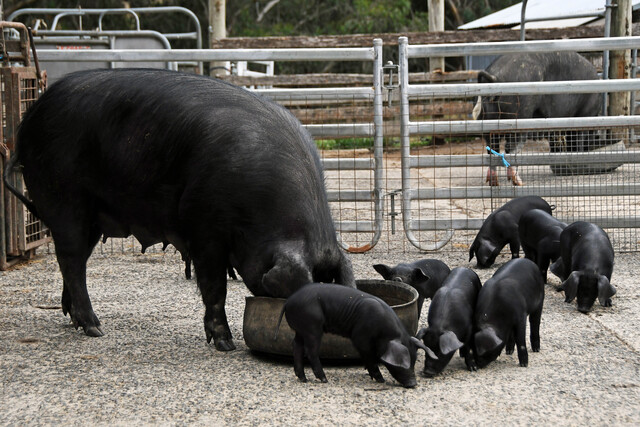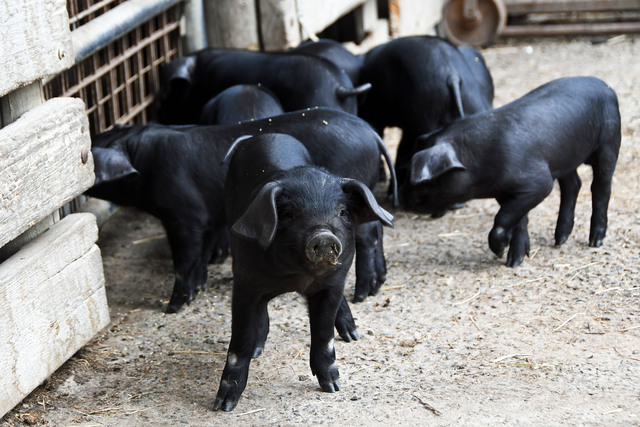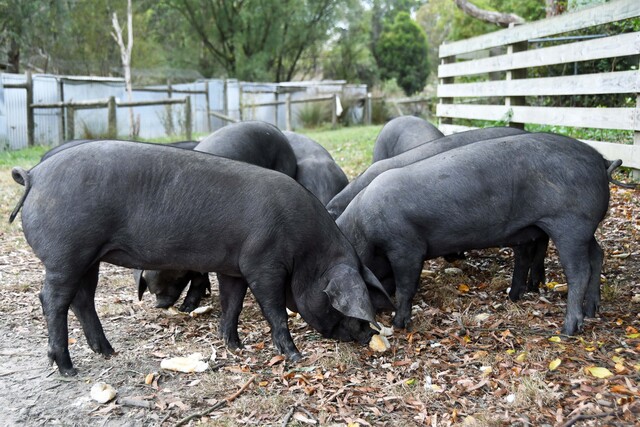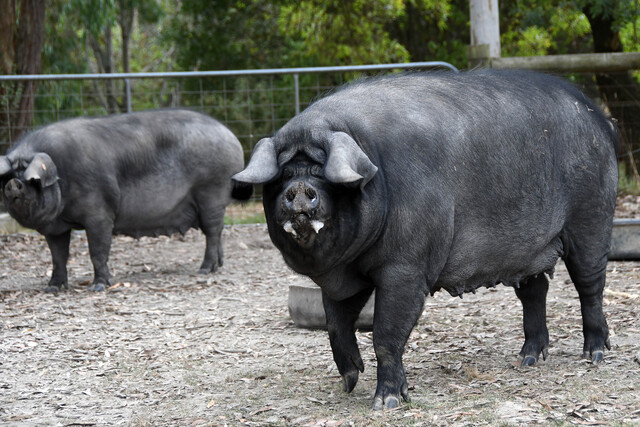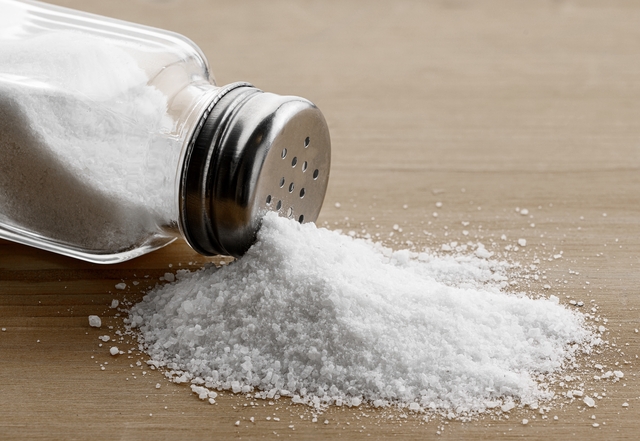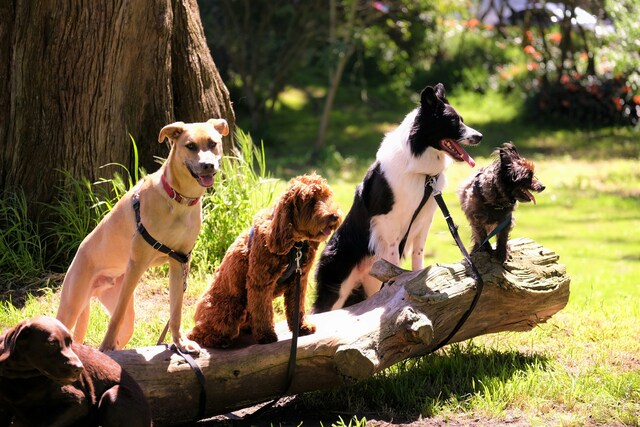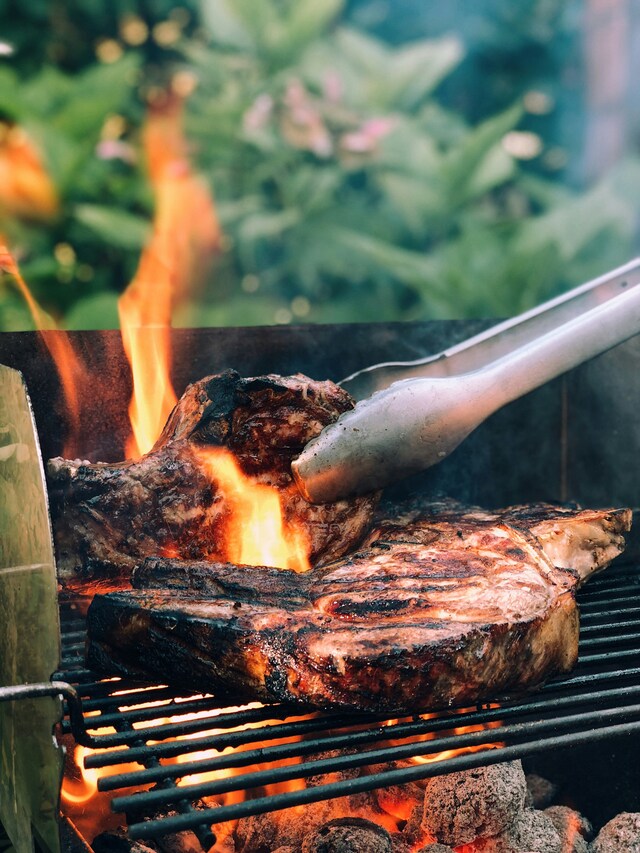PRECEDE
When one thinks of endangered species, breeds of pigs are not usually the first to come to mind, both for their presumed abundance and general ‘impurity’ as an animal. However, at Yarra Valley Free Range Pork in Macclesfield, it’s all about the purity and conservation of the endangered Large Black. Gazette journalist Corey Everitt spoke with Sally Willis about this property which was built by the hard work and dedication of her mother Christine Ross and about how the need to produce fresh meats is a mere means to the ultimate end of preserving this unique breed and giving them a long and happy life.
BREAKOUT QUOTE-
“While people say it’s no one’s business, I think animal welfare is everybody’s business.
At the farm nestled on Macclesfield Creek, a variety of rare species are bred on the paddocks from goats, sheep to pigs.
The most important one, of which the farm was initiated for, is the Large Black.
If you are unfamiliar with pigs, then possibly what comes to mind when you think of free ranging pigs is your fond memories of George Miller’s 1995 classic Babe.
But pigs are obviously far from the small, pink and soft spoken titular hero on the screen, and the Large Blacks specifically are the opposite.
Their immediate description is accurately described in the name. They are large, a boar can grow up to a weight of 350kg and a sow at 300kg. While there the tone of their hide is, as you can guess, as a uniform coat of black.
Their history and pedigree is where they stand unique as the genetic linkage to the hogs of Early Modern Britain and as a prized show breed.
“Back in the day, the Large Black was your, I suppose, sustainable pig. They were really really popular in the 60s, they can basically survive off the smell of an oily rag,” Sally Willis said.
“They were known as the lard pig because their fat is far superior than most others.”
“If you didn’t have a lot of a lot, you had a sow and a boar and you could obviously trade off the babies for other things.
“You could throw them scraps and they would be these huge fat animals and fat is flavour.”
The Large Blacks trace their genetics to a range of species throughout Southern and Eastern England in the sixteenth and seventeenth century, with their large population eventually emerging in East Anglia and Devon & Cornwall.
By the late 1800s, the Large Black and its classified purity was mostly formalised and it would become a popular and successful breed, both for farming and in shows.
Its population in England would start to decline by the mid-20th century after producers switched to other breeds.
In Australia they would be imported, chosen in part because they were found to have a better adaptability to the hotter climate. However, they never became widespread, only hovering around the 1 percent mark of all pigs in the country through the years.
They also have another rare breed at the farm, the Berkshire Pig, which is very similar in size, but different in appearance. They are generally considered vulnerable in their national and international conservation status.
Comparatively, the Large Black is in a far more dire status. By the Rare Breeds Trust of Australia they are considered critically endangered.
In the 1980s, there was little to – in some years – no registration of Large Blacks with the Australian Pig Breeders Society.
It was Sally’s mother, Christine Ross, who would become part of the effort to recover their numbers.
“My mum came out with her family as 10-pound poms and when she was little they would see the family doctor who had a farm,” Sally said.
“They didn’t have a lot of money so the doctor would take them to the farm, there were pigs and she was absolutely enamored with these pigs when she was a little girl.”
Going to Agriculture Shows and finding the Rare Breeds Trust of Australia she would learn of these breeds.
“She learnt about the large blacks and how they were becoming quite rare, she found two bachelor brothers near Colac,” Sally said.
“She went in and bought every single large black she could find from everywhere and then she had the largest group of proper registered pedigree large blacks.”
“That’s where the passion grew and then she learnt how great they were with their taste.”
It’s far from as simple as buying them and keeping them in a paddock.
“There is a whole contingency of what you have to be to be a rare breed,” Sally explained.
“There has to be purity along the way.
“One of the things I think my Mum quickly discovered was that you have to eat them to keep them going because who is going to have them as a pet in their backyard?
“People contact us and say ‘oh you’ve got pigs! I got one, I thought it was going to be small now it’s big, can you take it?”
Producing their meat is necessary to keep them, but it doesn’t thwart the ability to give them a long and happy life.
For many pigs it can be a life of only mere months where everything is done to bloat them out as fast as possible before the slaughter. Or it’s a life of a pet where they aren’t look after correctly.
At this farm, welfare is primary.
“When the pigs are alive here with us and here, they don’t want for anything. They are never hot, they are never cold, they always have food, they always have water, they are never sick, they are never fearful, there is nothing, none of that happens when they are here,” she said.
“Really important for people to understand that we always look after the pigs, there are always going to be people that don’t like what you do and that is okay, we need people that are very passionate about animals and animal welfare, otherwise people get away with anything.
“While people say it’s no one’s business, I think animal welfare is everybody’s business.
“I suppose for all of us, one of the things we say is you want a good life and a quick death and we ensure that both of those things happen.”
The sows stay on the farm their whole lives, where many farms would get rid of them once they are no longer useful.
However, it’s not about giving them pasture and leaving. There is as much attention to be paid in their later life than there is in their more productive years. Welfare can be just as much about easing pain than it is about preventing it.
“Animals, regardless of what anyone thinks, they don’t just pop over to the tree and go ’oh it’s my time’,” Sally said.
“It will hurt it’s leg, it’s hip will come out, it will be something catastrophic.
“So you have to make that decision relatively early on, you have to know your animals.
It takes a lot of work to manage the pigs throughout the farm between keeping their purity and providing the best life for them.
They get questions at markets and through the community about how you can produce and eat the meat of the pigs you so fondly cared for. Sally shows that the puzzlement should be the opposite way round.
“Our response, always to that, is how can you eat something that you don’t know where it has come from?” She said.
“How do you know what has happened to that animal, how do you know how it lived its life?
“For us, I can tell you everything.
“Most of the time when people learn about what we do and why we do it and why we are passionate about it, then they are more inclined to say yes I want that.”
Yarra Valley Free Range Pork can be found at a range of markets throughout the year.
The best way to acquire their products is directly through the farm shop, you can get into contact with them at christine@largeblackpigs.com.au.


